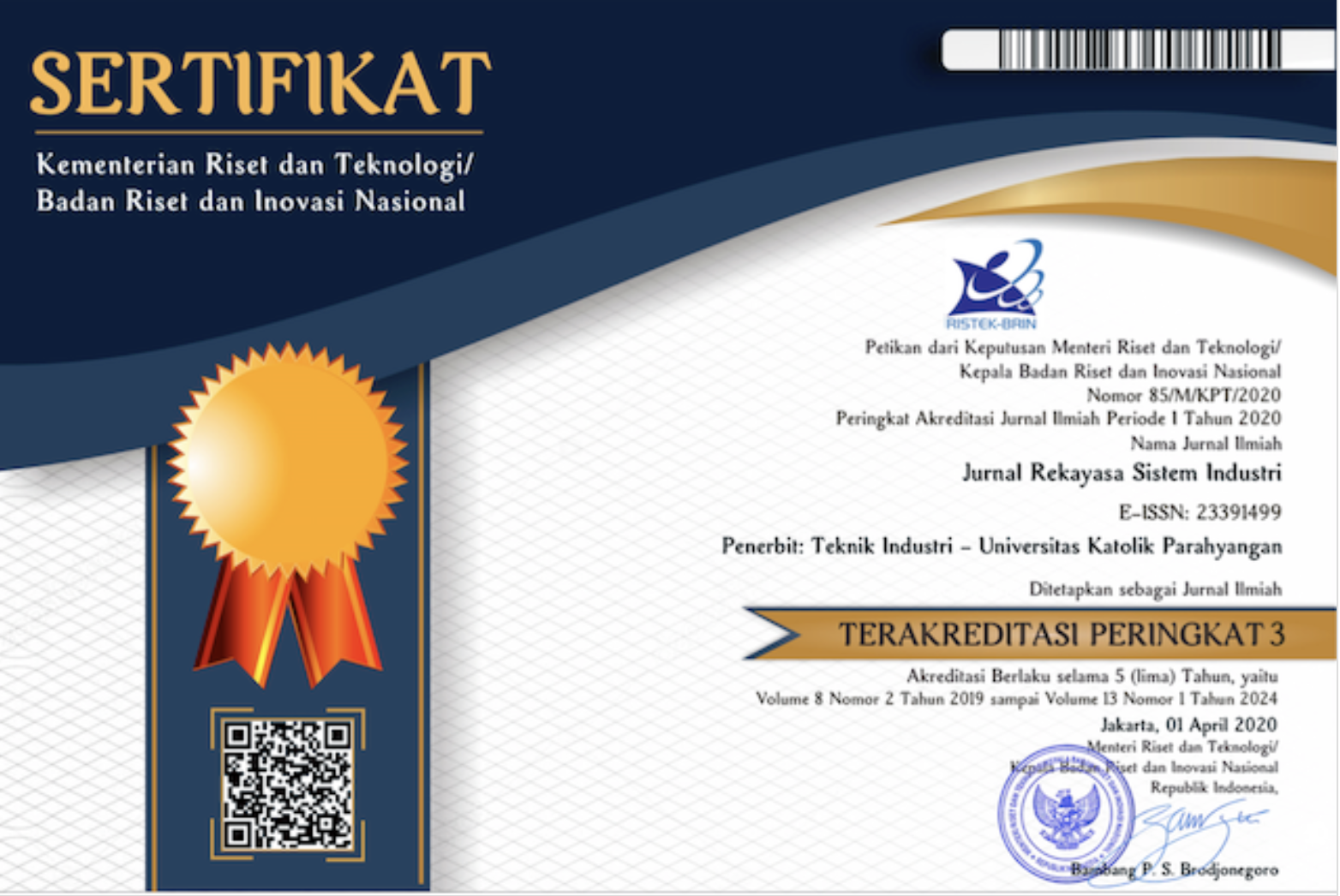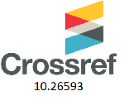Analisis Strategi Content Marketing pada PT. Saudagar Buah Indonesia Menggunakan Metode Six Sigma
DOI:
https://doi.org/10.26593/jrsi.v11i2.4543.221-228Kata Kunci:
pemasaran digital, pemasaran konten, Six Sigma (DMAIC), strategi bisnisAbstrak
Penelitian ini merupakan observasi lapangan pada PT. Saudagar Buah Indonesia, yang merupakan salah satu perusahaan yang menggeluti bidang makanan ringan dengan melahirkan sebuah produk yang dikenal dengan fruit strips. Sempat melakukan re-branding pada bulan Februari 2020 yang bertepatan dengan pandemi COVID-19, PT. Saudagar Buah Indonesia mengalami kesulitan dalam memasarkan produknya secara offline maka dari itu mereka memaksimalkan kegiatan pemasarannya secara online. Dalam memasarkan secara online tim marketing PT. Saudagar Buah Indonesia melakukan berbagai macam digital marketing, salah satunya yaitu content marketing. Tujuan dari penelitian ini adalah untuk mengetahui kelebihan, kekurangan serta memberikan perbaikan terhadap strategi content marketing yang dijalankan oleh tim marketing PT. Saudagar Buah Indonesia. Six Sigma adalah metodologi yang diterima industri dan terbukti digunakan untuk perbaikan proses bisnis. Metodologi ini dikenal sebagai metodologi disiplin untuk mendefinisikan, mengukur, menganalisis, meningkatkan, dan mengendalikan kualitas produk, proses, dan transaksi setiap perusahaan, dengan tujuan akhir hampir semua cacat dihilangkan, melalui tahapan yang dikenal sebagai DMAIC (Define, Measure, Analyze, Improve, dan Control). Metodologi Six Sigma dilakukan secara kualitatif dengan melakukan analisis permasalahan dan dilakukan pengendalian atau perbaikan setiap masing-masing masalahnya. Hasil penelitian dari penelitian ini, menghasilkan sebuah usulan perbaikan terhadap strategi content marketing yang dijalankan, yang mana perbaikan tersebut diharapkan dapat meningkatkan kualitas juga memperbaiki kekurangan.
Referensi
Ahmad, N. S., Musa, R., & Harun, M. H. M. (2016). The impact of social media content marketing (SMCM) towards brand health. Procedia Economics and Finance, 37, 331-336.
Du Plessis, C. (2017). The role of content marketing in social media content communities. South African Journal of Information Management, 19(1), 1-7.
Handes, H. (2019). Creative Planning dan Strategi Pengembangan Pesan Komunikasi Pemasaran. Al-Hikmah, 13(1).
Kabuhung, M. (2013). Sistem informasi akuntansi penerimaan dan pengeluaran kas untuk perencanaan dan pengendalian keuangan pada Organisasi nirlaba keagamaan. Jurnal EMBA: Jurnal Riset Ekonomi, Manajemen, Bisnis dan Akuntansi, 1(3), 339–348.
Karisnoviandi, A., Kastaman, R., & Ardiansah, I. (2017). Measurement Of Information Technology Used and Communication of Farmers Group In Sub-district of Jatinangor , Sumedang District. Journal of Industrial and Information Technology in Agriculture, 1(2), 8-17.
Karr, D. (2016). How to Map Your Content to Unpredictable Customer Journeys. San Francisco: Meltwater.
Kertamukti, R., Nugroho, H., & Wahyono, S. B. (2019). Kontruksi ldentitas Melalui Stories Highlight Instagram Kalangan Kelas Menengah. Jurnal ASPIKOM, 4(1), 26.
Lusiana, L., & Rahmiati, R. (2016). Analisa Tingkat Keberhasilan Strategi Promosi Terhadap Jumlah Mahasiswa Baru Menggunakan Metode Six Sigma (6σ). Prosiding Seminar Nasional APTIKOM (SEMNASTIKOM), 1(1).
Madhani, P. M. (2017). Six Sigma Deployment in Sales and Marketing: Enhancing Competitive Advantages. The IUP Journal of Business Strategy, 14(2), 40-63.
Muralidharan, K., & Raval, N. (2017). Six Sigma marketing and productivity improvement. A Quarterly Journal of the National Productivity Council, 58(1), 107-114.
Pandrianto, N., & Sukendro, G. G. (2018). Analisis Strategi Pesan Content Marketing untuk Mempertahankan Brand Engagement. Jurnal Komunikasi, 10(2), 167-176.
Pearson, N., Biddle, S. J., Williams, L., Worsley, A., Crawford, D., & Ball, K. (2014). Adolescent television viewing and unhealthy snack food consumption: the mediating role of home availability of unhealthy snack foods. Public health nutrition, 17(2), 317-323.
Pokharkar, D., Jadhav, V., Gholve, S., & Kadam, V. (2010). Six Sigma: Golden opportunity for pharmaceutical industry. International Journal of PharmTech Research, 2(2), 1160-1164.
Puduppully, R., Dong, L., & Lapata, M. (2019, July). Data-to-text generation with content selection and planning. Proceedings of the AAAI conference on artificial intelligence, 33(1), 6908-6915.
Pujianto, T., Hasbullah, R. A. S., & Ardiansah, I. (2017). Penilaian Kontribusi Komponen Teknologi dalam Aktivitas Produksi di PT Z Menggunakan Metode Teknometrik. Industria: Jurnal Teknologi dan Manajemen Agroindustri, 6(3), 133-144.
Puspitasari, P., Tresnati, R., & Oktini, D. R. (2017). Pengaruh Content Marketing Terhadap Minat Beli Konsumen (Survei pada Konsumen Thirteenth Shoes Bandung). Prosiding Manajemen, 116-121.
Putri, T. A., & Alfareza, M. N. (2019). Pengendalian Kualitas Produk Kaos Menggunakan Metode Six Sigma ( Studi Kasus pada Konveksi X di Yogyakarta ). Prosiding Seminar dan Konferensi Nasional IDEC, 2–3.
Safi’i, I., Widodo, S. R., & Pangastuti, R. L. (2020). Analisis Risiko pada UKM Tahu Takwa Kediri terhadap Dampak Pandemi COVID-19. Jurnal Rekayasa Sistem Industri, 9(2), 107–114.
Saraswati, D. A., & Hastasari, C. (2020). Strategi Digital Content Marketing pada Akun Media Sosial Instagram Mojok.co Dalam Mempertahankan Brand Engagement. Biokultur, 9(2), 152.
Setiawan, M. R., & Rachmawati, I. (2019). Strategi Digital Content Marketing Eiger Melalui Media Sosial Instagram. Prosiding Manajemen Komunikasi, 5(2).
Sulastri, L. (2016). Manajemen Usaha Kecil Menengah. Bandung: LGM-LaGood’s Publishing.













